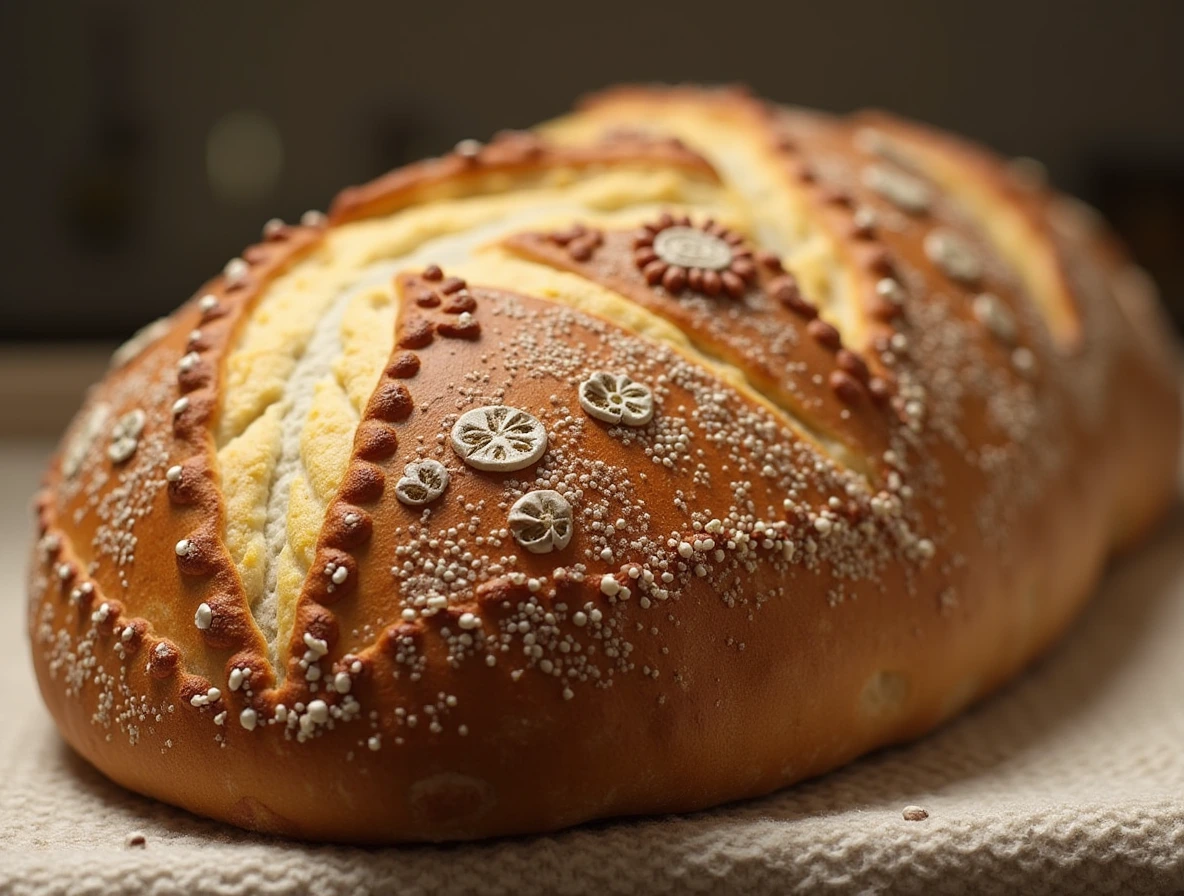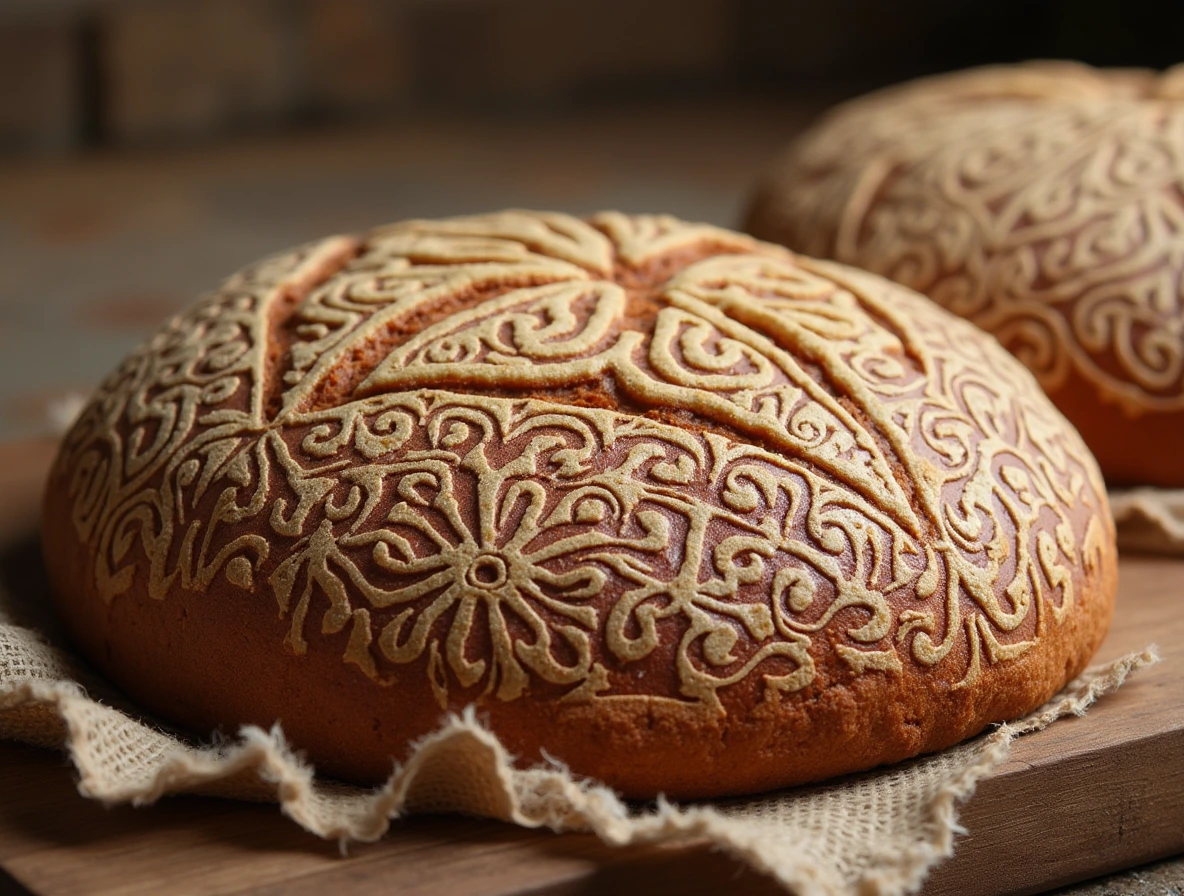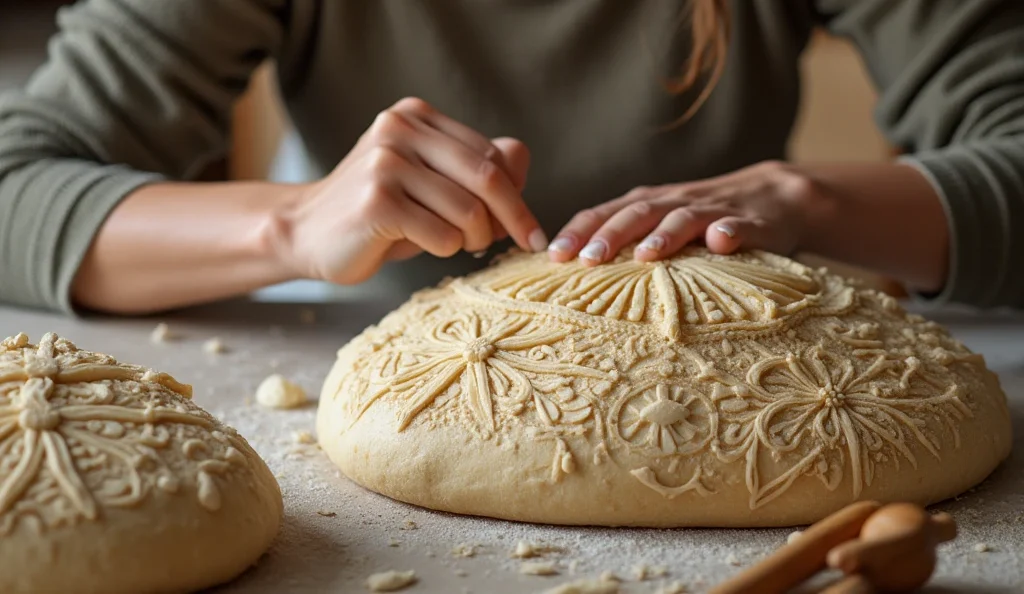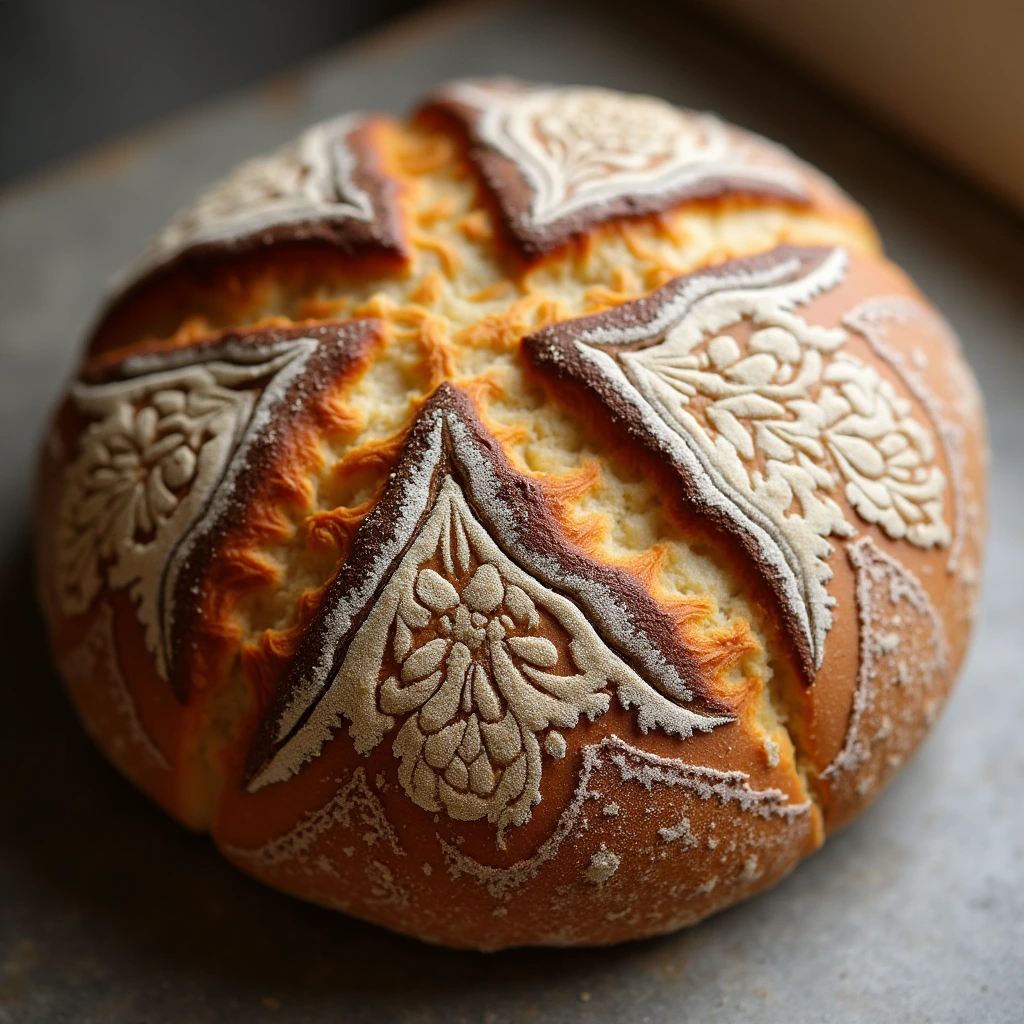1. Introduction
Decorated artisan bread is not just about baking; it’s a form of edible art. Whether you’re a beginner or an experienced baker, learning to decorate artisan bread elevates your baking to a whole new level. This guide will take you through the best creative designs, tips, and techniques to help you master the art of decorating your bread, no matter your skill level.
2. Understanding the Basics of Decorated Artisan Bread 🍞
2-1. What is Scoring? 🔪
Scoring is a technique where you slash the dough’s surface before baking, allowing the bread to expand and create stunning designs. It’s essential for achieving both aesthetic appeal and proper bread expansion.
2-2. The Importance of Scoring in Bread Decoration 🌟
Scoring not only adds beauty but also impacts the texture and rise of your bread. Mastering this skill will help you create clean, artistic lines and motifs on your decorated artisan bread.

3. Essential Tools for Decorated Artisan Bread 🛠️
3-1. Must-Have Tools for Perfect Scoring 🔪
- Bread Lame: A razor blade or sharp knife is necessary for clean, precise cuts.
- Flour Sifter: Evenly distribute flour to highlight your designs.
3-2. Enhancing Your Designs with Stencils and Flour Powder 🌾
- Stencils: Perfect for creating intricate and consistent patterns on the surface of the bread. They help achieve clean and uniform designs, which you can fill with powders like flour to enhance the details.
- Flour Powder: Dusting flour onto the surface of the bread through a stencil or directly with a sifter helps create contrasting patterns and highlight your designs. This simple yet effective technique can add a stunning visual effect to your creations.
4. Techniques for Beginners in Decorating Artisan Bread 👩🍳
4-1. Simple Scoring Designs ✂️
For beginners, start with easy designs like diagonal lines or a central cross, which help the dough rise evenly while adding a minimalistic touch to your bread.
4-2. Natural and Rustic Designs 🍃
Embrace natural motifs such as leaves, branches, or spirals for a rustic look. These designs are easy to achieve and add charm to your decorated artisan bread.

5. Advanced Techniques for Experienced Bakers 🍞
5-1. Creating Floral Patterns 🌸
Floral designs on decorated artisan bread require precision and an even distribution of flour. With the right technique, you can achieve intricate, beautiful results.
5-2. Geometric and Layered Scoring 🔲
Challenge yourself with geometric patterns or layered scoring. These designs can create depth and modern flair on your decorated artisan bread.
6. Perfecting Your Decorated Artisan Bread Patterns 🌟
6-1. Dough Hydration and Texture 💧
Ensure your dough is well-hydrated for easier and cleaner cuts. The ideal dough texture is soft but firm enough to hold the designs.
6-2. Steam Baking for Better Results 💨
Adding steam to your baking process helps your bread rise evenly and highlights the patterns, making your decorated artisan bread stand out beautifully.

7. Drawing Inspiration for Your Bread Designs 💡
7-1. Online Platforms for Ideas 🌐
Browse platforms like Pinterest for inspiration. You’ll find a wide range of 20+ Creative Artisan Bread Designs, including seasonal motifs that can spark your own ideas for decorated artisan bread.
7-2. Personalizing Your Bread for Special Occasions 🎉
You can also customize designs for holidays, celebrations, or personal milestones. Create snowflakes for winter or floral patterns for weddings or birthdays.
8. Troubleshooting Common Mistakes in Bread Decoration ❌
8-1. Avoid Shallow Scoring ⚠️
Shallow cuts often disappear during baking, leaving your design unnoticeable. Be sure to score deep enough to ensure your patterns stay visible.
8-2. Managing Flour and Baking Time ⏲️
Excess flour can cloud your design, and overbaking can cause the bread to become too dark. Keep track of these factors for optimal results.
9. The Role of Ingredients in Decorated Artisan Bread 🧂
9-1. Flour Quality and Its Impact 🌾
High-protein flour is crucial for achieving the perfect dough texture. It provides elasticity, which is necessary for clean and precise scoring.
9-2. Enhancing Flavor and Texture with Add-Ins 🌱
Incorporating seeds, herbs, or spices into your dough can elevate both the flavor and visual appeal of your decorated artisan bread.
10. The Baking Process for Decorated Artisan Bread 🔥
10-1. Preheating and Oven Setup ⚙️
Proper oven preheating is essential to ensure even baking. A stable temperature ensures that the patterns on your decorated artisan bread will bake beautifully.
10-2. Using a Pizza Stone or Dutch Oven 🍕
These tools help retain heat and create the ideal crust for your decorated artisan bread. They also promote even rising for flawless design patterns.
11. Tradition and Innovation in Decorated Artisan Bread 🔄
11-1. Blending Classic and Modern Techniques 🎭
Combine traditional scoring techniques with modern, creative designs to create unique, eye-catching decorated artisan bread.
11-2. Experimenting with New Patterns 🧩
Don’t hesitate to break the mold—mix classic designs with new ideas to showcase your personal style on each loaf.

12. Decorated Artisan Bread Around the World 🌍
12-1. Traditional Bread from Ukraine, Morocco, and France 🌸
Explore bread patterns from various cultures, such as the Korovai from Ukraine, which features floral and bird motifs, or Moroccan geometric designs reflecting Islamic art.
12-2. Bread Design in Different Cultures 🌐
Incorporating cultural elements into your decorated artisan bread can provide you with fresh ideas and deepen your understanding of this global art form.
13. Sharing Your Decorated Artisan Bread Creations 📸
13-1. Sharing on Social Media 📲
Show off your decorated artisan bread by posting pictures on social media. Not only does it celebrate your art, but it may inspire others to try their hand at bread decorating.
13-2. Gifting Your Masterpieces 🎁
Give your decorated artisan bread as gifts for holidays or special occasions. The thought and care behind the designs will make them even more meaningful.
14. Conclusion: 🌟
14-1. Embrace Your Creativity 🎨
Decorating artisan bread is an ongoing journey. Whether you’re a novice or an expert, every loaf provides a chance to explore new designs and techniques.
14-2. Let Your Imagination Run Wild 🧑🍳
The beauty of decorated artisan bread lies in its limitless potential for creativity. Continue refining your techniques, and soon your bread will become an edible work of art.
FAQ About Decorated Artisan Bread
A. What is artisan bread?
Artisan bread is handcrafted bread made using traditional techniques, often without preservatives or artificial additives. It typically has a rustic appearance, chewy texture, and a unique, rich flavor.
B. How is artisan bread different from regular bread?
Artisan bread differs from regular bread in its preparation method, ingredients, and texture. It is often made with simple ingredients, using long fermentation for better flavor and a crustier texture compared to mass-produced bread.
C. What makes decorated artisan bread unique?
Decorated artisan bread stands out due to its intricate designs, patterns, or added toppings such as seeds, herbs, or edible flowers. These decorations elevate the visual appeal and often enhance the flavor.
D. How do you create designs on artisan bread?
To create designs, score the dough with a sharp blade before baking. You can use stencils or freehand patterns, and dust with flour for contrast. The steam in the oven helps these designs stand out.
E. Can anyone make decorated artisan bread at home?
Yes, with some practice, anyone can create beautifully decorated artisan bread. Start with simple designs and gradually experiment with more intricate patterns as you gain confidence.
F. What are the best tools for bread decoration?
Essential tools include a lame (bread scoring tool), stencils, a pastry brush, and a sieve for dusting flour. These tools help achieve clean cuts and visually appealing designs.
G. What types of flour are best for artisan bread?
Bread flour, all-purpose flour, or whole wheat flour are commonly used. High-protein flours help create the chewy texture and structure typical of artisan bread.
H. How can I ensure a good crust on artisan bread?
To achieve a perfect crust, bake the bread in a preheated oven with added steam. You can place a tray of water in the oven or use a Dutch oven to trap moisture.
I. How long does artisan bread stay fresh?
Artisan bread stays fresh for 1-2 days at room temperature. Store it in a paper bag or bread box to maintain the crust. For longer storage, freeze the bread in an airtight bag.
J. Can you make gluten-free artisan bread?
Yes, gluten-free artisan bread can be made using gluten-free flour blends and specific techniques to ensure proper texture and structure.
K. What are common mistakes in making artisan bread?
Common mistakes include over-kneading, under-proofing, or baking at incorrect temperatures. These can lead to dense bread or an uneven crust.
L. How do you add toppings to artisan bread?
Add toppings like seeds, nuts, or herbs before baking. Brush the surface of the dough with water or egg wash to help the toppings stick.
M. Why is steam important in baking artisan bread?
Steam creates a humid environment in the oven, which helps the bread expand and develop a crispy, golden crust. It also enhances the appearance of scored designs.
N. Can I use sourdough starter for artisan bread?
Yes, sourdough starter is commonly used for artisan bread, adding depth of flavor and a slightly tangy taste.
O. How do you prevent dough from sticking during shaping?
Use a lightly floured surface and floured hands to prevent sticking. Avoid adding too much flour, as it can affect the dough’s texture.
P. How long should artisan bread dough be proofed?
Proofing time varies but typically ranges from 2 to 4 hours, depending on the recipe and room temperature. A slow, cool proof enhances flavor.
Q. What are some unique decoration ideas for artisan bread?
Try using leaf or floral stencils, intricate scoring patterns, or creating themed designs for special occasions. Adding colored dough for contrast can also create striking visual effects.
R. Is decorated artisan bread only for visual appeal?
No, while the visual aspect is important, the added decorations like seeds or herbs can enhance the bread’s flavor and texture, making it more enjoyable to eat.
S. How can I serve decorated artisan bread?
Serve it as an appetizer with olive oil and herbs, alongside soups or stews, or as part of a charcuterie board. Its visual appeal makes it ideal for special occasions or gatherings.
If you’re a fan of creativity, explore other themes like creative cookies 🍪✨😉
Your Feedback Inspires Us, Share It!
There are no reviews yet. Be the first one to write one.

